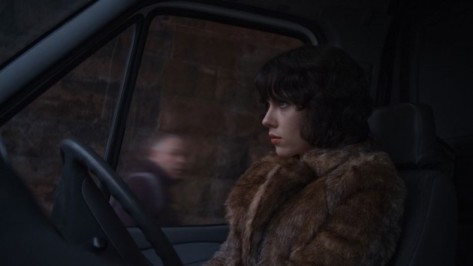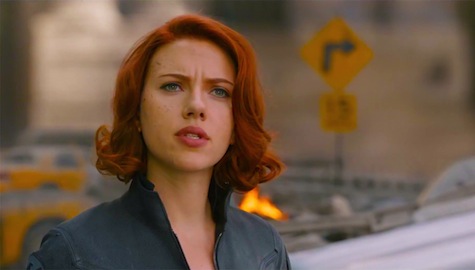While we’re waiting to see whether or not Marvel will finally give Black Widow her own stand alone film, we can take this moment to look at the place Scarlett Johansson plays in the current universe of cinematic science fiction.
It’s interesting to recall that just a few years ago, Johansson was known primarily as an indie darling. After cutting her teeth as a child star in the 90s (most notably in Robert Redford’s The Horse Whisperer), she transitioned into more adult roles in 2001 with the one-two punch of Ghost World and The Man Who Wasn’t There. Though those two films were miles apart in subject matter, they had some tonal similarities—focusing on the existential ennui of a harried protagonist—Ghost World’s caustic high schooler Enid (Thora Birch) and Man’s laconic barber Ed (Billy Bob Thornton). Playing a supporting role in both films, Johansson’s character is inaccessible—a vision that the protagonist can’t reach. In Ghost World, she’s the childhood friend who grows up and away, lost to young adulthood. In The Man Who Wasn’t There, she’s the underage object of an older man’s shy desire, a would-be Lolita for a near-mute Humbert Humbert.
She would play more objects of desire in films like Lost In Translation (2003) and Match Point (2005), but there was always more than a bit of melancholy in these roles. In Lost In Translation she was an unhappily married woman, adrift in her own life. In Match Point, she appeared to be a femme fatale leading a man to his doom…until it turns out to be the other way around. By this point, Johansson was a full fledged sex symbol. And I mean that quite literally. She was functioning as a symbol of sex within the semiotic systems of these films. The much talked about opening shot of Johansson in her underwear at the beginning of Lost In Translation, for example, is about more than just her celebrated backside. Consider: she’s not dancing around shaking her famous derriere; she’s not “being sexy.” She’s lying there bored and alone in a hotel room. So that shot is a picture of what happens to a person once the thrill of sexuality starts to subside. Yeah, she has a nice ass, the film seems to say, but then what?
Flash forward to 2014 and Johansson now occupies an interesting place in our current movie landscape. She still likes making smaller indie movies (Hitchcock, Don Juan), but she’s become a pivotal part of the world of sci-fi and comic book films as well. Starting in 2010’s Iron Man 2, she became Natasha Romanoff AKA Black Widow. Now, the thread tying together the Marvel cinematic universe is unquestionably Samuel L. Jackson’s Nick Fury, but I think the case can be made that Johansson’s Black Widow is really the heart of this particular series of films. She links Iron Man to The Avengers and then links that film to The Winter Solider. It’s not just that she appears in all three films, it’s that she has the most interesting perspective on the events unfolding. She’s close to the center of S.H.I.E.L.D—helping to guide Tony Stark into a working relationship with Fury, convincing Bruce Banner to join The Avengers, and ultimately helping Steve Rogers to bring down S.H.I.E.L.D. Even more than Fury, her loyalties are a mystery. Of the members of the Avengers, in fact, she’s really the only one with secrets left to reveal.

Outside of the Marvel universe, Johansson’s role in the current cinematic landscape becomes even more interesting. She notched her biggest solo hit so far with Luc Besson’s Lucy, a film which extends her screen persona by tapping into a couple of things we’ve come to associate with her. First, ass-kicking. At this point, Johansson’s slain enough people/aliens/robots onscreen that she’s a bona fide action star. The second thing, however, is a little more ineffable. It’s a certain blank quality that she has, and this goes to the question of whether she’s a compelling actor or just a compelling screen presence (or if, indeed, there’s much difference between those two things). For much of Lucy, Johansson is expressionless, her character’s personality being subsumed into some kind of expanded consciousness (if I follow the film’s popcorn metaphysics correctly). This seems tailor made for Johansson, whose sleepy eyes and throaty voice can betray (or seem to betray) a certain vacuousness.

You can see this most clearly in Jonathan Glazer’s sci-fi/horror/art flick Under The Skin (2013). Johansson plays an alien driving around Scotland in a van, picking up random men for sex. The men don’t get the sex they expect; instead, they’re submerged in a pool of weird black goo. We’re never told exactly what the alien is collecting the men for, but it doesn’t seem to be anything good. Although she’s the villain of the piece (the scene where she picks up a young man with neurofibromatosis is the most disturbing scene Johansson’s ever played), she begins to take on human attributes. By the end, when she’s attacked in the woods by a sexual assailant, she’s terrified and our sympathies are completely with her. Under The Skin is a difficult movie, but it features a fascinating performance from Johansson that—taken with her work in Lucy—shows her being utilized by very different directors in interesting ways.
Johansson occupies an interesting place in the current landscape of science fiction and comic book films. She’s not the Queen of Sci-fi because, no contest, the Queen of Sci-fi is Zoe Saldana. Saldana is warm and human (and not just as the warm and human Uhura in Star Trek but as the aliens Neytiri in Avatar and Gamora in Guardians of the Galaxy), so the reason you put Zoe Saldana in a movie is because she’s instantly likable. Johansson’s a little different, though. She can “do” warm, as she did in The Prestige or as the voice in Her, but there’s something cooler-to-the-touch about her, a reticence and restraint that makes her a different kind of presence than Saldana. She’s both a more sexualized figure (the seductress) and a more dangerous figure (the cold-eyed killer). Like, I dunno, a black widow.
Jake Hinkson is the author of the novels Hell On Church Street and The Posthumous Man, as well as the novella Saint Homicide. Read more about him at JakeHinkson.com and his blog, The Night Editor.










